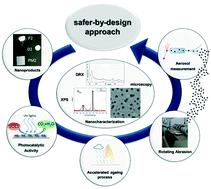当前位置:
X-MOL 学术
›
Environ. Sci.: Nano
›
论文详情
Our official English website, www.x-mol.net, welcomes your
feedback! (Note: you will need to create a separate account there.)
Characterization of photocatalytic paints: a relationship between the photocatalytic properties – release of nanoparticles and volatile organic compounds
Environmental Science: Nano ( IF 5.8 ) Pub Date : 2017-08-02 00:00:00 , DOI: 10.1039/c7en00467b D. Truffier-Boutry 1, 2, 3, 4 , B. Fiorentino 1, 2, 3, 4 , V. Bartolomei 1, 2, 3, 4, 5 , R. Soulas 1, 2, 3, 4 , O. Sicardy 1, 2, 3, 4 , A. Benayad 1, 2, 3, 4 , J.-F. Damlencourt 1, 2, 3, 4 , B. Pépin-Donat 1, 4, 6, 7, 8 , C. Lombard 1, 4, 6, 7, 8 , A. Gandolfo 4, 5, 8, 9, 10 , H. Wortham 4, 5, 8, 9, 10 , G. Brochard 4, 11, 12 , A. Audemard 4, 11, 12 , L. Porcar 4, 13, 14 , G. Gebel 1, 2, 3, 4 , S. Gligorovski 4, 5, 8, 9, 10
Environmental Science: Nano ( IF 5.8 ) Pub Date : 2017-08-02 00:00:00 , DOI: 10.1039/c7en00467b D. Truffier-Boutry 1, 2, 3, 4 , B. Fiorentino 1, 2, 3, 4 , V. Bartolomei 1, 2, 3, 4, 5 , R. Soulas 1, 2, 3, 4 , O. Sicardy 1, 2, 3, 4 , A. Benayad 1, 2, 3, 4 , J.-F. Damlencourt 1, 2, 3, 4 , B. Pépin-Donat 1, 4, 6, 7, 8 , C. Lombard 1, 4, 6, 7, 8 , A. Gandolfo 4, 5, 8, 9, 10 , H. Wortham 4, 5, 8, 9, 10 , G. Brochard 4, 11, 12 , A. Audemard 4, 11, 12 , L. Porcar 4, 13, 14 , G. Gebel 1, 2, 3, 4 , S. Gligorovski 4, 5, 8, 9, 10
Affiliation

|
Photocatalytic TiO2 appears to be a promising material to eliminate many air pollutants such as nitrogen oxides (NOx) and volatile organic compounds (VOCs). However, a number of questions remain unanswered prior to its full optimization. Some photocatalytic materials are already commercialized but their photocatalytic effects are questionable. In the present study, characterization of two paints for indoor and outdoor applications, one containing micro-sized titanium dioxide (TiO2) particles and the other based on nano-TiO2, is undertaken in order to understand their environmental impact during the use phase. The photocatalytic efficiency of the paints is determined before and after climatic ageing. The degradation of the paints induced by their ageing is characterized in parallel. Powders, dispersions and paints applied on a substrate are investigated to characterize the state of the nanoparticles (NPs) as a function of their surrounding media. The abrasion of the photocatalytic materials indicates that the presence of TiO2 (NPs) enhances the organic matrix degradation of the paints due to a greater photocatalytic effect. The online and continuous measurements by PTR-ToF-MS indicate that the degradation of the organic matrix leads to release of organic compounds (formaldehyde, methanol, acetaldehyde and formic acid) into the air which suggests that monitoring only the removal of VOCs (in this case xylene) is not enough to make a proper evaluation of the effectiveness of photocatalytic paints towards VOC elimination. These VOCs emerge exclusively from the degradation of the organic matrix as much lower VOC emissions were measured in the case of the aged paint which exhibits a lower amount of organic components in the matrix. This study links the morphological observations, chemical determination, structural parameters and photocatalytic properties of the paints for future optimization of safer-by-design photocatalytic paints.
中文翻译:

光催化涂料的表征:光催化性能之间的关系-纳米颗粒和挥发性有机化合物的释放
光催化TiO 2似乎是消除许多空气污染物(如氮氧化物(NO x)和挥发性有机化合物(VOC))的有前途的材料。但是,在对其进行全面优化之前,仍有许多问题尚未得到解答。一些光催化材料已经商业化,但是它们的光催化作用值得怀疑。在本研究中,表征两种用于室内和室外的涂料,一种包含微米级的二氧化钛(TiO 2)颗粒,另一种基于纳米TiO 2的颗粒。,以了解其在使用阶段对环境的影响。在气候老化之前和之后确定涂料的光催化效率。同时表征了由于老化引起的涂料的降解。研究了施加在基材上的粉末,分散体和涂料,以表征纳米颗粒(NPs)的状态与周围介质的关系。光催化材料的磨损表明存在TiO 2(NPs)由于更大的光催化作用而增强了涂料的有机基质降解。通过PTR-ToF-MS进行的在线和连续测量表明,有机基质的降解会导致有机化合物(甲醛,甲醇,乙醛和甲酸)释放到空气中,这表明仅监测VOC的去除情况(在此情况下) (例如二甲苯)不足以对光催化涂料消除VOC的有效性做出适当评估。这些挥发性有机化合物仅来自有机基质的降解,因为在老化的涂料中,基质中有机成分的含量较低,因此测得的挥发性有机化合物排放量要低得多。这项研究将形态学观察,化学测定,
更新日期:2017-08-25
中文翻译:

光催化涂料的表征:光催化性能之间的关系-纳米颗粒和挥发性有机化合物的释放
光催化TiO 2似乎是消除许多空气污染物(如氮氧化物(NO x)和挥发性有机化合物(VOC))的有前途的材料。但是,在对其进行全面优化之前,仍有许多问题尚未得到解答。一些光催化材料已经商业化,但是它们的光催化作用值得怀疑。在本研究中,表征两种用于室内和室外的涂料,一种包含微米级的二氧化钛(TiO 2)颗粒,另一种基于纳米TiO 2的颗粒。,以了解其在使用阶段对环境的影响。在气候老化之前和之后确定涂料的光催化效率。同时表征了由于老化引起的涂料的降解。研究了施加在基材上的粉末,分散体和涂料,以表征纳米颗粒(NPs)的状态与周围介质的关系。光催化材料的磨损表明存在TiO 2(NPs)由于更大的光催化作用而增强了涂料的有机基质降解。通过PTR-ToF-MS进行的在线和连续测量表明,有机基质的降解会导致有机化合物(甲醛,甲醇,乙醛和甲酸)释放到空气中,这表明仅监测VOC的去除情况(在此情况下) (例如二甲苯)不足以对光催化涂料消除VOC的有效性做出适当评估。这些挥发性有机化合物仅来自有机基质的降解,因为在老化的涂料中,基质中有机成分的含量较低,因此测得的挥发性有机化合物排放量要低得多。这项研究将形态学观察,化学测定,











































 京公网安备 11010802027423号
京公网安备 11010802027423号